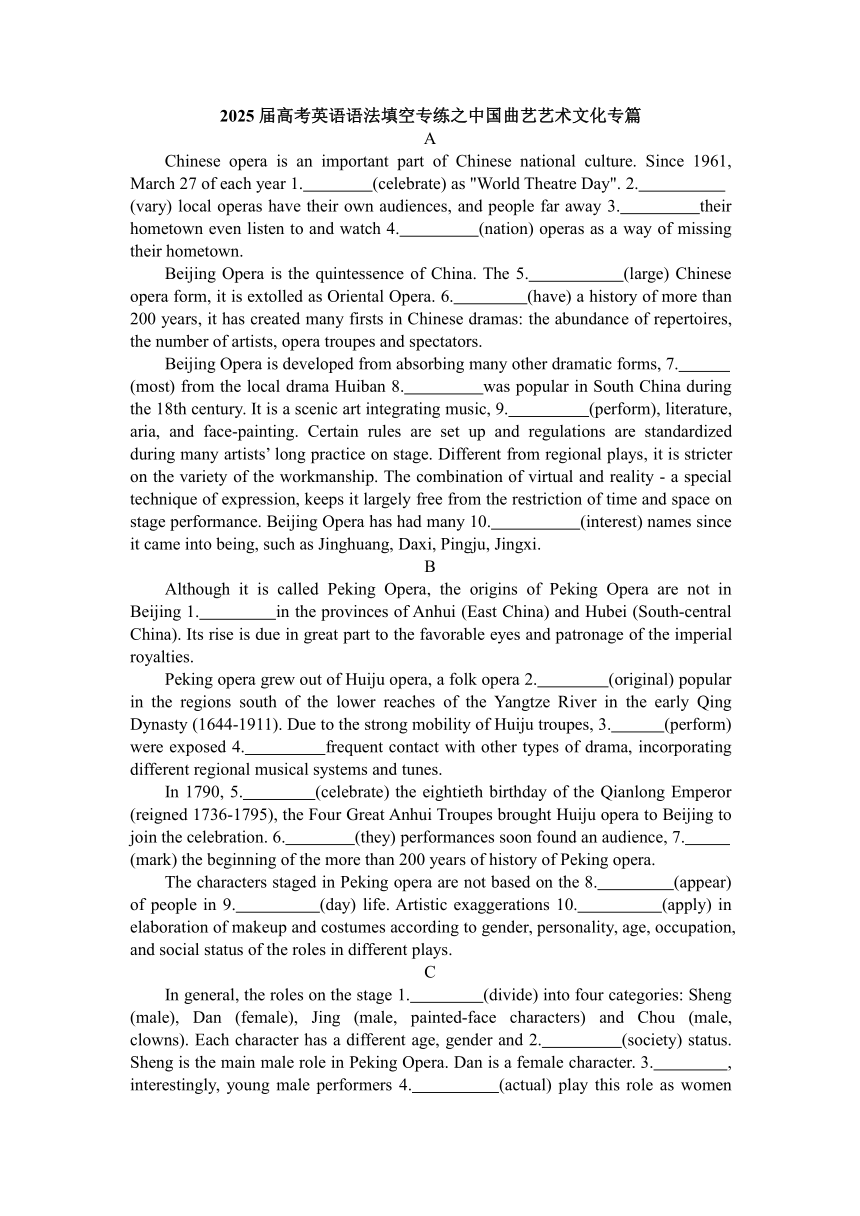
2025届高考英语语法填空专练之中国曲艺艺术文化专篇 A Chinese opera is an important part of Chinese national culture. Since 1961, March 27 of each year 1. (celebrate) as "World Theatre Day". 2. (vary) local operas have their own audiences, and people far away 3. their hometown even listen to and watch 4. (nation) operas as a way of missing their hometown. Beijing Opera is the quintessence of China. The 5. (large) Chinese opera form, it is extolled as Oriental Opera. 6. (have) a history of more than 200 years, it has created many firsts in Chinese dramas: the abundance of repertoires, the number of artists, opera troupes and spectators. Beijing Opera is developed from absorbing many other dramatic forms, 7. (most) from the local drama Huiban 8. was popular in South China during the 18th century. It is a scenic art integrating music, 9. (perform), literature, aria, and face-painting. Certain rules are set up and regulations are standardized during many artists’ long practice on stage. Different from regional plays, it is stricter on the variety of the workmanship. The combination of virtual and reality - a special technique of expression, keeps it largely free from the restriction of time and space on stage performance. Beijing Opera has had many 10. (interest) names since it came into being, such as Jinghuang, Daxi, Pingju, Jingxi. B Although it is called Peking Opera, the origins of Peking Opera are not in Beijing 1. in the provinces of Anhui (East China) and Hubei (South-central China). Its rise is due in great part to the favorable eyes and patronage of the imperial royalties. Peking opera grew out of Huiju opera, a folk opera 2. (original) popular in the regions south of the lower reaches of the Yangtze River in the early Qing Dynasty (1644-1911). Due to the strong mobility of Huiju troupes, 3. (perform) were exposed 4. frequent contact with other types of drama, incorporating different regional musical systems and tunes. In 1790, 5. (celebrate) the eightieth birthday of the Qianlong Emperor (reigned 1736-1795), the Four Great Anhui Troupes brought Huiju opera to Beijing to join the celebration. 6. (they) performances soon found an audience, 7. (mark) the beginning of the more than 200 years of history of Peking opera. The characters staged in Peking opera are not based on the 8. (appear) of people in 9. (day) life. Artistic exaggerations 10. (apply) in elaboration of makeup and costumes according to gender, personality, age, occupation, and social status of the roles in different plays. C In general, the roles on the stage 1. (divide) into four categories: Sheng (male), Dan (female), Jing (male, painted-face characters) and Chou (male, clowns). Each character has a different age, gender and 2. (society) status. Sheng is the main male role in Peking Opera. Dan is a female character. 3. , interestingly, young male performers 4. (actual) play this role as women were prohibited from acting until 1912. In Mandarin, “jing” means clean. The face pai ... ...
~~ 您好,已阅读到文档的结尾了 ~~

